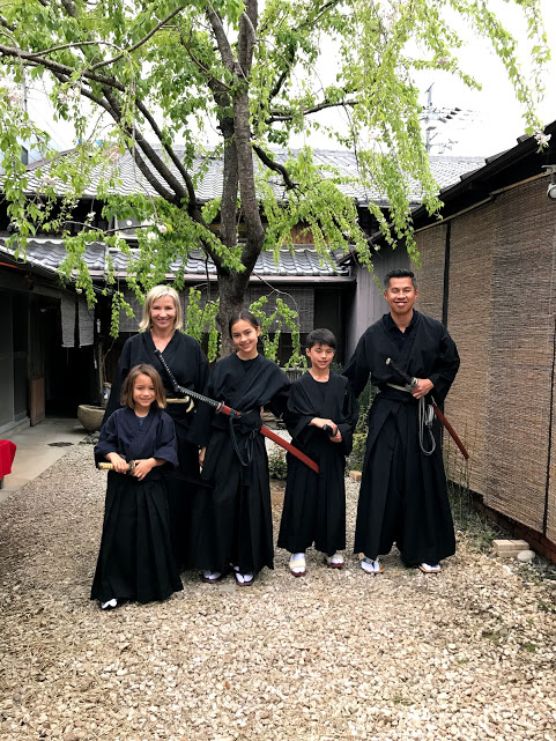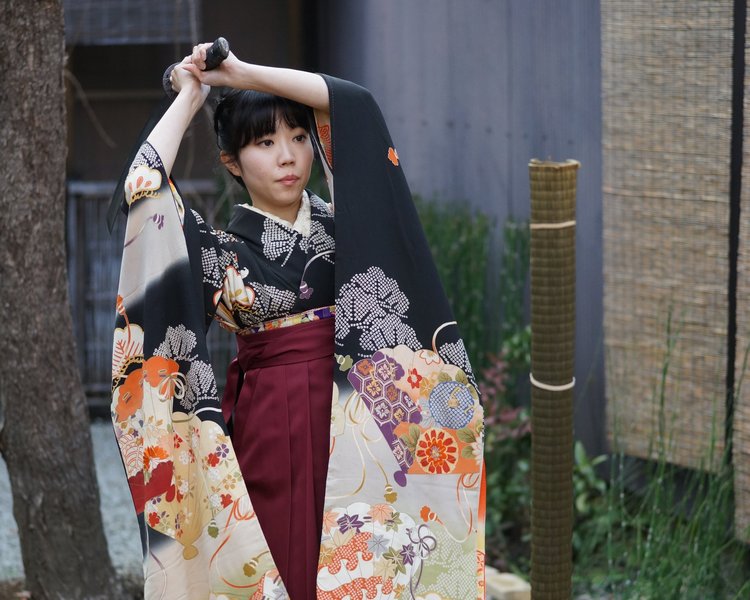京都でのサムライ体験
Earlier this year, members of our team went to Samurai Juku to try out one of the most popular experiences among travelers when coming to Japan: A Samurai Experience. We learned cool stuff and had much fun. Today I’ll share all of it with you! Are you ready? Let’s wield!
My first encounter with Japanese culture goes back from my childhood. When I was about 10, my parents took me to Aikido classes because they wanted me to be able to defend and protect myself in all circumstances. At first, I was not fond of Aikido, because we had to remember the names of the techniques we used, which were, of course, in Japanese, and it also missed the kind of action I was expecting from Martial Arts. But as time went by, I enjoyed Aikido more and more, especially when we did forward rolls (mae ukemi) and learned movements “Kata” with wooden swords. I liked it so much that I even did the kata at home. Later, my aikido sensei (teacher, master) took me to the theater to watch The Last Samurai ( do you remember this movie?), and since then, my interest in Samurai and the Japanese sword grew stronger and stronger.
The bottom line is that If you are also active in Aikido or any other martial arts or are just curious about Samurai, the experience provided by Samurai Juku is an excellent way to enter the world of the Japanese warriors. So, shall we go?
Discover Samurai Juku
In the north of Kyoto, close to Kyoto Imperial Palace and Imagegawa station (Karasuma subway line), stands an old two-stories townhouse (Kyomachiya) like so many others in this ancient district, formerly the very center of Kyoto city due to its close position to the Imperial residence. A discreet wood plank carved サムライ塾 lets you know that you are in the right place. The main window is latticed, and the entrance door is veiled by a Japanese curtain called Noren. In fine weather, the entrance door is left open, but the Noren keeps the secret of what’s awaits us inside. An exciting moment isn’t it!?
Once you entered the house, you can feel right away the atmosphere of the old days. It offers all the features of a typical machiya: a narrow frontage, a deep depth, a courtyard in the back, a long corridor between the entrance and the back, with the Japanese cooking stoves, tatami rooms, wood for the sliding doors and the beams. I regret I did not ask when the residence was built because you can feel the soul of the old house so strongly.
We were welcomed by Luis, our interpreter for the afternoon, and taken to the main room of the ground floor where a beautiful collection of warriors armors is displayed. Luis described their characteristics and uses while all the participants gathered. Then he quickly announced the flow of the session and introduced us to Master Kawata.
Portrait of a Samurai’s descendant

Kawata sensei is an Iaido’s master. The Iaido refers to the art of drawing the Japanese sword or katana smoothly. Hailing from a long line of Samurai, Kawata sensei is a Renshi, which is one of the three higher titles for instructors. It can only be obtained by those who completely mastered the regular grades system, ranked from shodan チェックアウト日 judan, and passed a written examination. So we can say it: he is the crème de la crème!
Samurai Juku, the flow of the experience

Transformation
First, we change into the clothes that the Samurai were wearing in everyday life. A hakama, which is wide trousers tied at the waist with a belt, over a kimono. The traditional clothing being pretty large, you can keep your clothes beneath the hakama. For the footwear, you will be given Japanese socks called tabi. The tabi includes a space to separate the big toe from the other toes to facilitate the wearing of sandals. When moving outside, slippers will be provided.
Performance
Kawata sensei will show a few Iaido techniques. Look carefully the way he drags the sword out before to put it back and how smooth his movements are. It looks incredibly easy to do, but is it?
Insight into the traditions and the culture of Samurai
The history of Samurai and Iaido is pretty long and intense, so do not expect a complete course of the hows and why, but the essentials will be explained for you to understand who were the Samurai and the spirit of the sword. If you have any questions for Master Kawata regarding the samurai lifestyle, the sword making, the different kinds of swords, particular iaido movements of whatsoever, feel free to ask. Master Kawata will be more than happy to share all of that with you ~
Training
Sensei showed you the way, and you might have thought it was not a big deal, now It’s your turn to shine! Feel the weight of the sword when you draw it. Listen to the wind when you wield it. It is a powerful feeling even for those who trained with a wooden sword before, as it was my case. I was captivated by the sword.
Tameshigiri
You learned how to drag, wield, and put back the katana. The final part of the training is a cutting test using a rolled bamboo mat (tatami). It is called tameshigiri. Tameshigiri is usually used to check the quality of the sword. There exists a multitude of ways to cut the rolled tatami. Beginners will perform a one-cut tameshigiri. More experimented aikidoka could try a two-cuts technique, but it requires a pretty high level of skills.
Why do we recommend Samurai Juku over other Samurai experiences in Kyoto?

Unique and humble instructor: One of the reasons why you should go to Samurai Juku has already been mentioned just above. It is Kawata sensei, a first-rank sensei who will share his knowledge humbly about Samurai and swords with visitors and locals. Feel at ease, asking all the questions you would have for Kawata sensei. An interpreter will be at your side for a smooth conversation.

Real Japanese sword: While there are a few places where you can have a “samurai experience” in Kyoto, Samurai Juku is the only one ( I am aware of, and a did a lot of research!) that offers a real insight into the world of Samurai. Also, contrary to other providers where you will use the real sword only for a few minutes, at Samurai Juku, you will hold an authentic Japanese sword (not a replica) during the whole session. Furthermore, the swords that will be presented to you are master Kawata’s personal collection swords! Some of them are more than 500-year-old. You will be able to truly feel the weight and spirit of a traditionally made katana.

High flexibility and customization: Master Kawata adapted his teaching based on the level of the participants and can accommodate special requests (with advance notice) for those who want to deepen their learning. You can bring your whole family to have fun or book the Master one week for private and intensive training.
Ready to challenge yourself?
We are more than happy to arrange this highly recommended experience for our dear guests. For further information about Samurai Juku’s training session, click こちら. Book your vacation home and Samurai Juku experience こちら!











